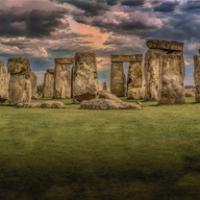history of garden design

medicinal herbs garden
April 11, 2019
Life and food
May 23, 2019The history of garden design – how did it all begin?
Written by Ronen Kozushner
Orseeds.com naseeds.com
When talking about the history of decency design, we talk about art, aesthetics, nature, style and culture. The reflection of all the elements in the design of gardens throughout history and to this day is very moving and clarifies the changes and changes that have occurred over the years.
The philosopher Peter Drucker said that “the best way to predict the future is to invent it.” On the other hand, most historians say that in order to better understand the future, we must explore the past. Either way, in every area of life we search past and check where it all started, how the methods and ideas were created, and where the inspiration came from. And the truth? It is always intriguing and interesting to know.
We, who are involved in the design of gardens, decided to raise the gauntlet and begin to explore the subject, and embark on a magical and interesting historical journey. Did it start in ancient Egypt, and perhaps in Greece? How did the ancient gardens evolve to what we know today? Here’s all the information we’ve collected.
That’s how it started: a brief overview – from then until today
Gardening has existed since the beginning of history, and has undergone many vicissitudes over the years. Gardens were established for the purposes of holiness and religion, growing vegetables and fruits, recreation and of course also for the elderly. Many studies have shown that in ancient times, the gardens benefited mainly kings and aristocrats. Later on, the area also reached the Christian monasteries, palaces in Islamic countries and the Far East, and slowly the design of gardens became accessible and accessible in every corner of the world and to all people.
Egypt – We begin in a very early period around the seventh millennium BCE, and we see that the settlement of ancient Mesopotamia had already begun, and the planning of the houses and gardens already included elements of landscape architecture in human planning, and the ancient gardens in Babylon are evidence of this. In Babylon and in other cities in Mesopotamia, was the planting of trees and the flow of water to them.
First evidence of the existence of ancient gardens in Egypt, indicate that already in this early period designed gardens ornamental ponds, including fish or flowers, and through them also irrigated the plants in the garden. Archeological remains have been found for more than 5,000 years, including designs of gardens that included ponds, shade areas planted with trees and flower beds. Further evidence of this is found in the paintings of the Egyptian tombs, where drawings of trees surrounding the lotus flowers are clearly visible in Egyptian culture. Another important element in the gardens were small temples that served both as a design motif and as a religious place. Archaeologists who studied ancient Egypt found the remains of Pharaoh’s palace in the city’s excavations, which included a large garden, from which the Nile River flowed. The gardens of the palace raised trees, vines, flowers and herbs.
Persia- Design of ancient gardens We will see later in the area of Mesopotamia, whose main theme is the Hanging Gardens in Babylon. For the Babylonians the gardens were a holy place, for they believed that this was the dwelling place of the gods. They designed the gardens as a temple surrounded by trees, for it was their belief that the gods were in the trees. In addition, they tried to create the gardens as an imaginary paradise, an imitation of the world to come.
The Gardens Dependent on Babylon – Although they have not yet been able to prove their existence, the Hanging Gardens in Babylon are considered one of the seven wonders of the world. They are also known as the Hanging Gardens of Semiramis, and evidence of their existence can be found in ancient archeological remains. Although they are not mentioned in the heritage of Babylonian culture, but are described in detail as genes unusual in Greek historians. According to legend, King Nebuchadnezzar II (604 BCE-562 BCE) built the Hanging Gardens on the banks of the Euphrates River for his wife Princess Amitis, who loved the mountain landscape. The garden trees were planted on terraces, with the top step about 25 meters above ground, which made it seem as if the gardens were suspended in the air. The gardens built an irrigation system that originated in the Euphrates, and in ancient times was considered very sophisticated. In the second century CE, after a number of earthquakes, the gardens were completely destroyed. Archaeologists have suggested that the Hanging Gardens were built near the royal palace in the Old City of Babylon. In contrast, other archaeologists believe that the gardens were built in the ancient city of Nimrod, and there is also a conjecture that these were all in the gardens of the Assyrian king’s palace around 700 BC on the banks of the Tigris.
Not at the beginning of the count – the gardens in Athens revolve around gardens designated for religious purposes. They designed gardens with tree-lined statues. The planning was more meticulous in the belief that they were meant for gods. The trend has spread to other countries in Europe, and the frescoes in the city of Pompeii, an ancient Roman city in Campania, Italy, attest to a significant development in the planning of gardens. The paintings show the construction of large gardens that belonged to the city’s wealthy, including fountains, rockeries and large vegetation. The design of gardens in Greece developed towards the beginning of the count, when planning underwent a transformation from gardening to temples, creating spaces designed for entertaining. Luxurious gardens served the country’s rich as a meeting place and a fine area for parties. In the sixth century BCE, the Greeks changed their perception of the planning of the gardens, where the agora was planned differently than usual, until then only dwellings were built, during which time sewage and drinking water systems were added, many.
Europe to the Middle Ages – Planning gardens in Europe rose a step, and already in 300 AD landscaping has become an integral part of the occupations of monks throughout Europe, especially in France and England. The gardens surrounding the monasteries planted fruit trees, planted vegetables, herbs, medicinal and healing herbs, and of course, various flower seedlings. After about 400 years, towards 700 AD, the areas designated for the gardens were already included in the planning of the monasteries, and were a symbol of status and honor.
The temples of Islam – this pattern of creating gardens dedicated to the gods and symbolizing the Garden of Eden, also passed to the period of Islam. In ancient Islamic temples it is clear that the temple is in the center of the garden and has four directions, a symbol of the four rivers that emerge from the Garden of Eden. The source of the water lies in the heart of the Temple, from which water is nourished. Reference to this is found in the Koran, which presents the Islamic concept that the Garden of Eden revolves around a central axis of water sources or long channels where water flows, surrounded by many fruit trees.
The Far East – The art of design of ancient gardens did not skip China either, and one can certainly say that the ancient style was preserved there to this day. The art of landscaping in the East was based on a unique concept in which the garden is a place for solitude and inner contemplation, when the design was based on natural elements of soil and water. At the same time, Japan developed a unique tradition of the Zen Garden (Japanese Garden), a design that combined Japanese art known for its aesthetic concept with a design based on Japan’s unique lifestyle. They created gardens in a minimalist but modestly designed style, combining elements found in the Chinese gardens.
The Middle Ages – the Renaissance – the period of cultural flowering, did not skip any field, including the design of the gardens. This period, which began in Italy during the Middle Ages (from the 14th to the 17th centuries), led the design of gardens to a different dimension. During this period large and wide gardens were planned and in fact combined the design of the garden with nature, whether in a natural way compared with the existing conditions of the area, or in the creation of artificial lakes, which created a spectacular reflection of the palaces and houses.
At the beginning of the 14th century, the country’s wealthy enjoyed luxurious gardens, expansive lawns and sculpted bushes, which are in fact the most prominent feature of the French garden as we know it to this day. In the 16th century, Spain saw the sprouts of public gardening, with green parks and large gardens where large fountains and statues were erected. One of the oldest preserved to date is the Almeda Hercules Square in Seville, which was founded in 1574. At the beginning of the 17th century, the design of gardens underwent a transformation from natural design to precise and geometric style. The gardens of Versailles in France are an example of meticulous landscaping, in symmetrical and straight lines. At the end of the 17th century in France, gardens began to be built adjacent to private homes. During this period in Italy they began to design open spaces alongside intimate spaces of enclosed courtyards, including stylized flower beds with an element of geometrical shapes.
Europe in the 18th century – it can be said that in the 18th century large and well kept gardens could be seen mainly in palaces, estates and rural European aristocracy, and a few small private gardens that were in the villages. The 18th century gardens of France’s magnificent palace of Versailles are well described. In the 17th century, Louis XIII purchased the gardens and on the western side of the castle were planted the first gardens, and they remained for 30 years, until their expansion in the 18th century, on the The gardens are decorated in the style of a classic French garden and are decorated with many fountains, statues and statues, with huge wood groves separating the formal gardens from east to northeast, and fountains (for example, the Apollo fountain) From impressive lists of sculptures, long water channels (eg, the large canal, which is 1,500 meters long and 62 meters wide), terraces (for example, The official entrance from the palace to the gardens), groves with clusters of trees (Boschettes) etc. The vast gardens of Versailles have undergone five new plantings over the centuries, for various reasons, including: diseases that harmed trees, kings who for aesthetic reasons required other trees to graze, The gardens, which were built during the Louis XIII period, were initially launched using local spring water, and after the expansion they were forced to build a new irrigation system that could provide the increased water consumption.The water system was expanded to include a reservoir that conveyed water directly to the garden fountains and a water tower that received water directly from Lake Clani A windmill and pumps operated on me The horses. It was only after the construction of the Grand Canal in 1671 that the water of the gardens began. The shortage of water for running the fountains continues to this day. Today, water is being pumped faster from the large canal to the fountains, using modern pumps, and a rainwater harvesting system is being used. To this day, the Garden Rehabilitation Program is being implemented, in which the genes are restored and preserved. If you would like to read more about the design of a modern French garden, click here.
Another style that developed in the 18th century is the English Garden, which has become a unique style in landscape architecture and is still popular today. The design of the English Garden is based on the design of a romantic garden, which despite its meticulous planning seems natural and unplanned. The gardens are characterized by wide lawns, combining ornamental ponds with fish and flowers, planting trees in a free and unorganized manner, and creating artificial landscapes with natural appearance, all to emphasize the power and beauty of nature.
Europe in the 19th century – this stormy century brought with it an abundance of renewal and modernism. The design of decency was based on a new perspective influenced by the Romantic movement, with a romantic country-style garden design. The style became natural again with a rustic hue, and the view of the gardens was more romantic and soft. In gardening comes the creation of a landscape picture with different designs of flowers and plants, games of light and shade, a combination of many flowers, creating terraces and stairs and more.
After the industrial revolution that began in England and spread to all of Europe, toward the end of the 19th century, accelerated the development of large cities, and then began a process that included more modern urban planning. The revolution brought about economic and social changes that included many changes in agriculture and gardening work, as was the practice until then. The urban spaces became green public areas, parks and public gardens were established, and then the basis for planning and urban landscape architecture began to grow as we are aware of it today. At the same time, greater awareness has emerged for the establishment of private gardens, adjacent to private homes, and as a public space in high-rise buildings.
20th Century – Home Gardening – Garden design is actually a combination of different shades of art. After reading the review, you must have understood that what began as a domain that belonged to kings, aristocracy and the upper class only, began to be common in all strata of the population. Today it can be said that a private house with a well-tended garden is a symbol of status and quality of life, and this is certainly within the reach of every private house owner. The initial investment and ongoing maintenance are definitely individual to each and according to the existing budget, but there is no doubt that this is more possible than ever.
The design of the modern garden from the 20th century is based on landscape architecture in a variety of design styles. The common denominator between them is the design of private and public areas, both around the buildings and in open spaces, with reference to the conditions of the area and the creation of harmony between nature or structure, for the design of the garden. Today, the design of each complex, ranging from different public areas in the cities to the design of private homes, including landscape planning. Designing and nurturing private gardens is now a profession in itself, but it is also a very enjoyable hobby for a large part of private homeowners. It is also possible to see an expansion in the benefits produced by the gardens, and beyond the construction of gardens where fruit and vegetables, fruit trees, herbs and more are also grown






